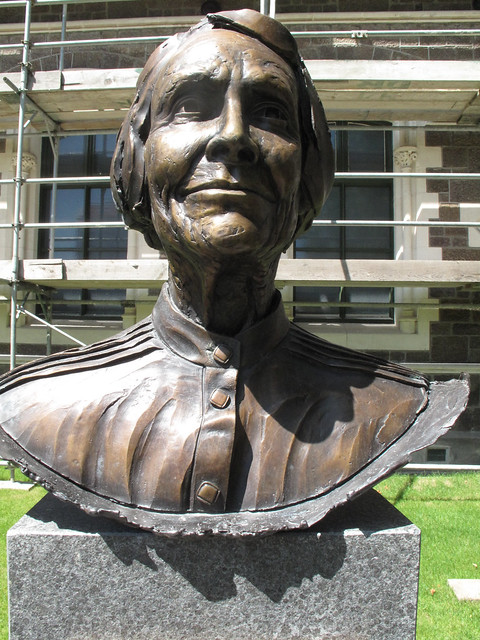Elsie Locke 1912-2001
"Political, social and local community activist, well-loved historian and writer, determined and doughty fighter for the rights of the under-dog, active to the end."
Elsie Locke is one of the Twelve Local Heroes, a set of bronze busts sculpted by Mark Whyte.
Elsie’s plaque reads:
"Political, social and local community activist, well-loved historian and writer, determined and doughty fighter for the rights of the under-dog, active to the end."
Photos
Photos of the Elsie Locke bust
The twelve heroes were chosen by the Local Heroes Trust whose members include former Christchurch Art Gallery Trust chairman Chris Brocket, Arts Foundation of New Zealand trustee Ros Burdon, Susan and Jim Wakefield, and Sir Miles Warren.
Information about Elsie Locke from the Twelve Local Heroes trail at the University of Canterbury
Elsie Locke was born in Hamilton on 17 August 1912, and lived in Waiuku. Her parents were William John and Ellen Farrelly. She was the youngest of six children. She completed a Bachelor of Arts at Auckland University in 1933. She started writing at school and had some articles and stories published in the New Zealand Herald. She moved to Christchurch with her husband Jack (John Gibson Locke) during World War II and lived in the same cottage in the Avon Loop for over 40 years. She was the mother of four children, two sons and two daughters.

Elsie wrote extensively for children, about New Zealand history and about the peace movement. She was a lifelong political activist, peace campaigner and feminist. She was active at community level in the Avon Loop, as well as campaigning to retain and improve Christchurch’s Centennial Pool (the neighbouring park was named after her in 1997 and is now incorporated into the Margaret Mahy playground).

She helped to found the Sex Hygiene and Birth Society which later became the Family Planning Association.
Locke was also a key figure in the restoration, with native plants, of the banks of the Avon as it flowed through the Avon Loop. She was a foundation member of CAFCINZ (now CAFCA) (Campaign Against Foreign Control in New Zealand) in 1975 and continued her membership until her death on 8 April 2001 in Christchurch.
Elsie Locke
The Runaway Settlers
The Runaway Settlers is the novel that Elsie Locke is best known for. It is based on the true story of the Small family. The novel describes the conditions the Small family were facing that lead to emigration and follows their first impressions of New Zealand, the struggle of surviving in an unforgiving new land and the outcome of these trials.
The Canterbury setting of the novel has remained popular in Christchurch in particular, with children able to recognise the geographical locations of the family's adventures. Descendants of the Small family are still living in Governors Bay today.
The strengths of the novel are the accuracy of Elsie's research, with every detail true to life, and the believable characters. Elsie researched thoroughly to find out about the time and place the novel was set in, and with her imagination weaves this research into an exciting account of colonial life in Canterbury.
More about Elsie Locke
- Photos of Elsie Locke on Canterbury Stories
- Biography of Elsie Locke from the NZ Book Council
- Maureen Birchfield. Locke, Elsie Violet, Dictionary of New Zealand Biography, first published in 2018. Te Ara - the Encyclopedia of New Zealand, (accessed 17 August 2022)
- Elsie Locke: 1912 - 2001 - essay about Elsie Locke by economist, Brian Easton. Gives background on her political thinking in particular.
- Obituary for Elsie Locke on the converge website
- Resources about Elsie Locke from DigitalNZ
- The Elsie Locke Memorial Trust website
The Peace Library
Christchurch City Libraries’ Peace Library is a collection of books and magazines held in trust by Christchurch City Libraries for the Peace Foundation and the Women’s International League for Peace.



